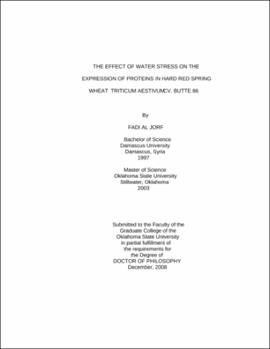| dc.contributor.advisor | Rayas-Duarte, Patricia | |
| dc.contributor.author | Al Jorf, Fadi | |
| dc.date.accessioned | 2013-11-26T08:22:30Z | |
| dc.date.available | 2013-11-26T08:22:30Z | |
| dc.date.issued | 2008-12 | |
| dc.identifier.uri | https://hdl.handle.net/11244/6579 | |
| dc.description.abstract | Scope and Method of Study: Environmental changes including water stress affect the wheat quality and yield. This study attempts to explore the effect of water stress on the storage and specific organelle proteins' expression in hard red spring wheat Triticum aestivum cv Butte 86 during development. Wheat plants were grown in a greenhouse under optimum and 30% water-stressed conditions. Both plant treatments received adequate nitrogen fertilization and spikes were harvested at 14, 34 days after anthesis (DAA) as early and late stage of endosperm development respectively. The mature wheat grains were harvested at 60 DAA. Gliadin, LMW-GS, and HMW-GS of mature wheat were differentially extracted with solvents. Proteins characterizations were obtained by their hydrophobic properties via reverse phase-high performance liquid chromatography (RP-HPLC), mass to charge ratio using capillary zone electrophoresis (CZE), molecular weight via sodium dodecyl sulfate-polyacrelamide gel electrophoresis (SDS-PAGE), and isoelectric point and molecular weight using two-dimensional (2-D) gel electrophoresis. While the endoplasmic reticulum (ER) and golgi complex (GC) from 14 and 34 DAA were fractionated using sucrose gradient and analyzed by 2-D electrophoresis. Proteins were analyzed by peptide mass fingerprinting and identified with protein database. | |
| dc.description.abstract | Findings and Conclusions: Based on equal volume of extraction, higher relative amount of protein from RP-HPLC area of gliadins and LMW-GS of stressed compared to optimal fractions, while lower relative amount of protein concentration was observed in the stressed fractions of HMW-GS compared to optimal fractions, with the caveat that systematic errors in actual protein amount may occur. Water stress produced change in the expression of HMW-GS 5+10 which are encoded by the gene Glu-D1 by upregulating the Glu-D1x and downregulating the Glu-D1y. During early and late stages of development several starch synthesis proteins were identified accompanied with upregulation of the expression of stress and defense proteins. Dehydrin, Hsp26, Glutathione-S-Transferase, and receptor-like kinase among stress response proteins were good candidates to have an inhibition effect on starch synthesis enzymes that need to be further investigated. | |
| dc.format | application/pdf | |
| dc.language | en_US | |
| dc.rights | Copyright is held by the author who has granted the Oklahoma State University Library the non-exclusive right to share this material in its institutional repository. Contact Digital Library Services at lib-dls@okstate.edu or 405-744-9161 for the permission policy on the use, reproduction or distribution of this material. | |
| dc.title | Effect of water stress on the expression of proteins in hard red spring wheat Triticum aestivum cv. Butte 86 | |
| dc.contributor.committeeMember | DeWitt, Christina Mireles | |
| dc.contributor.committeeMember | McGlynn, William | |
| osu.filename | AlJorf_okstate_0664D_10141.pdf | |
| osu.accesstype | Open Access | |
| dc.type.genre | Dissertation | |
| dc.type.material | Text | |
| dc.subject.keywords | proteomics | |
| dc.subject.keywords | water stress | |
| dc.subject.keywords | wheat | |
| thesis.degree.discipline | Food Science | |
| thesis.degree.grantor | Oklahoma State University | |
